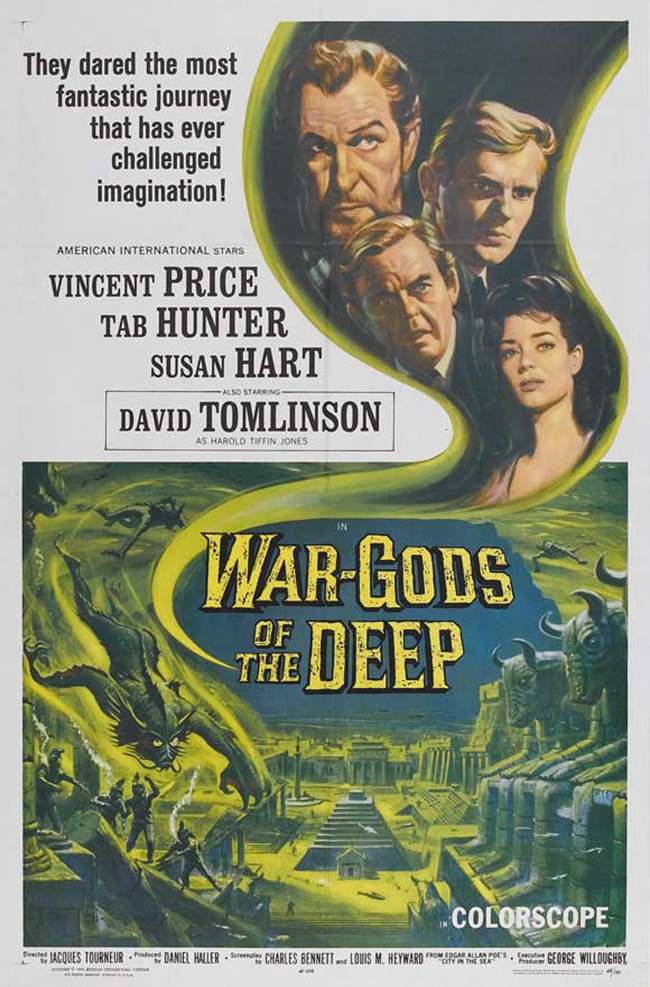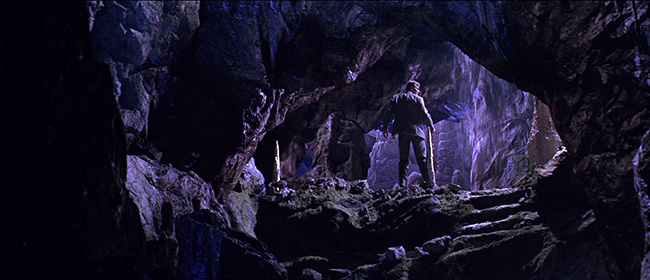
The drive for American International Pictures to continue exploiting the box office hit combo of Vincent Price and Edgar Allan Poe produced some strange results, such as the unexpectedly delightful comedy The Raven (1963) – which has nothing to do with the poem – or The Haunted Palace (1963), which borrowed a title from the author but a story (The Case of Charles Dexter Ward) from H.P. Lovecraft. But perhaps the most unusual bit of Poesploitation from the independent studio was War-Gods of the Deep (1965). Wikipedia doesn’t even include it in the studio’s Poe cycle, which is understandable, because it’s called War-Gods of the Deep for crying out loud. But it is, in fact, drawn from Poe’s poem “The City in the Sea,” and the title used in the U.K. was City Under the Sea. In the film, Price recites multiple times from the poem, and the intrepid explorers even uncover a “first edition” volume of Poe’s poetry. Nonetheless, the connection feels even more strained than in the Lovecraft film. War-Gods has other, more obvious roots: Jules Verne’s 20,000 Leagues Under the Sea and Journey to the Center of the Earth seem inspirational, not to mention Lovecraft’s “Dagon” and “The Shadow Over Innsmouth.” That may seem like a dream mixture of elements for genre fans, but something goes awry in the laboratory. War-Gods is a bit of everything, and a whole lot of nothing.
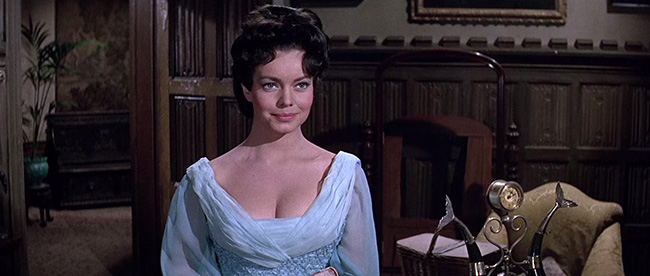
Susan Hart as the damsel in distress, Jill Tregillis.
But for a while, at least, it feels like a lost masterpiece of Victorian-era fantasy. The film starts strong, and with the appearance of the words “Directed by Jacques Tourneur,” one has every reason to get excited. Tourneur brought style and tension to his genre outings in the 40’s and 50’s. His films for Val Lewton – Cat People (1942), I Walked with a Zombie (1943), and The Leopard Man (1943) – are required viewing for anyone interested in directing horror and suspense, as is his later Night of the Demon (1957). His thriller Out of the Past (1947) is a classic of film noir. Tourneur had previously worked with Price (and AIP) with the Richard Matheson-scripted The Comedy of Terrors (1963), a black comedy co-starring Peter Lorre and Boris Karloff. (Despite that line-up, the film, unfortunately, is not terribly funny.) As War-Gods opens, it’s easy to appreciate Tourneur’s contributions. The film is Gothic gorgeous, with deep shadows and rich blues capturing the rainswept coast, its huddled, fearful denizens, and the cliff-perched mansion, Tregathian. Price introduces the film, narrating an excerpt from “The City in the Sea.” And Tab Hunter (Damn Yankees!) makes for an appealing young hero, with a slight edge that so many protagonists in these films often lack; he’s simply interesting to watch. Susan Hart (The Slime People, Pajama Party) nicely fits her role, as well, which is the token buxom damsel in distress. Signs of worry creep in with the performance of David Tomlinson (Mary Poppins) as an obvious comic relief type, a painter who paints his own portrait, sets to work in the early morning on a picture of the sunset because he’s a “slow worker,” and is always seen with his treasured rooster named Herbert. Nonethless, the mystery – which involves “gill men” stealing into the estate and kidnapping Hart – sets a Lovecraftian mood. As Hunter and Tomlinson trigger a hidden passage behind a bookshelf (sorry – sigh – the rooster triggers it), and explore a series of evocatively-designed, waterfall and whirlpool-filled caverns, all shot by Tourneur like illustrations from a turn-of-the-century adventure novel, it’s easy to start falling in love with War-Gods of the Deep. Well, but for the rooster.
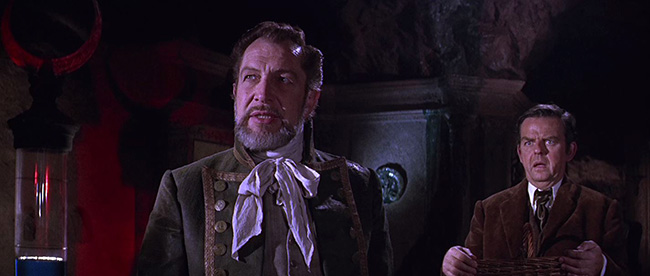
Sir Hugh (Vincent Price) shows the undersea city to Harold Tufnell-Jones (David Tomlinson).
Anyway, that’s when it starts to break your heart. There just isn’t very much that happens in the secret underwater realm discovered by Hunter and Tomlinson. A Nemo-like captain named Sir Hugh (Price) rules with an iron fist over smugglers – who, like Hugh, are immortal for obscure reasons having to do with their submerged environment – as well as the “Gill Men,” who are actually called that in the film, and in underwater footage swim about in neat wetsuit costumes ruined by terribly phony masks. Creatures of the Black Lagoon they aren’t. “They believe that I am Death!” Price boasts. His cavernous lair lies next to a ruined, drowned city (from Poe’s poem) and a smoldering volcano ready to blow. (The Gill Men were formerly residents of the city.) Price wants to keep his (dull) paradise going by preventing the eruption of the volcano; tricked into thinking Hunter and Tomlinson are great scientists, he keeps them until they can come up with a solution. In a subplot like an afterthought, Jill bears an uncanny resemblance to Price’s old love, “Beatrice,” depicted in a portrait hanging on his wall. If nothing else, this one idea is reminiscent of the Corman/Price/Poe films, but nothing is really done with it, and its only plot function is to justify Jill’s kidnapping.
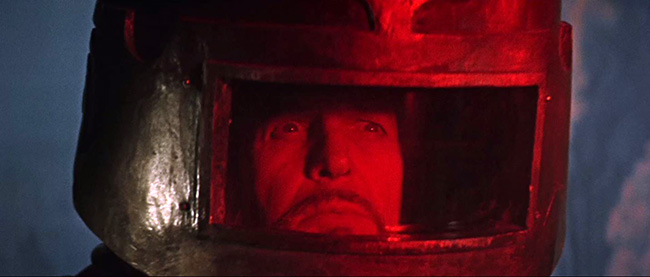
Price explores the ocean floor in a diving suit.
The art direction, by Frank White (The Face of Fu Manchu), is quite good, and most impressive is a temple set in which our heroes huddle behind the fingers of a giant stone hand. The temple is used to drown sacrificial victims, and water comes spurting between the great fingers. But the “lava” that later invades the cavern, bursting through cracks in the wall, looks like oatmeal. It’s an oddly appropriate symbol: despite Tourneur’s Gothic flair, nice set design, and the presence of the always-enjoyable Price, there is nothing really here, no real foundation, nothing to hold the great pouring oatmeal of this film at bay. It is hard to ignore the fact that War-Gods of the Deep has only a wisp of a plot. (The plot is this: “I’m going to kidnap this girl. Can you stop my volcano from exploding? No? Guards! Stop them from escaping! Here’s some more from Poe. Roll credits.”) The climax of the film is a drawn-out underwater battle in Verne-style diving suits and with Gill Men. It suffers the same problem as Thunderball (1965), which is that “underwater battle” looks a lot better in a screenplay than it does on the big screen. Underwater fighting is lethargic – there’s no way around it. The attention starts to wander. You begin to question if the editor was aware that Herbert the Rooster, squeezed into Tomlinson’s diving helmet, shifts from one of Tomlinson’s shoulders to the other, over and over and over again, as though he’s glitching in and out of another dimension. Is it deliberate – a joke? I couldn’t tell you. War-Gods of the Deep is not a terrible film; there’s too much in it that’s interesting, that’s appealing, for me to dislike it. It passes the time on a weekend afternoon. It looks great on the new Blu-Ray from Kino. But it never coalesces. It’s a broken pile of great ideas that not even the great Jacques Tourneur can piece together.
